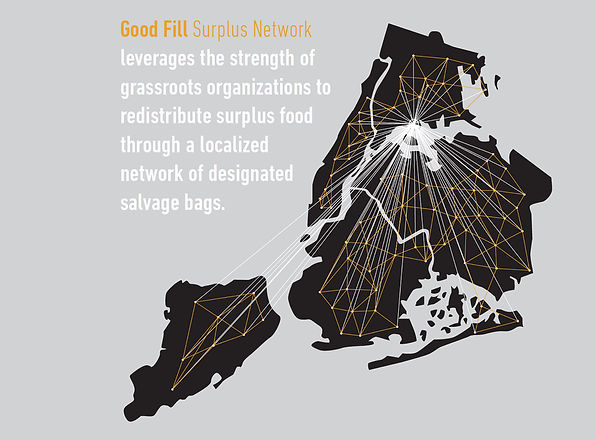?
How might we make left-over, edible food products available to hungry New Yorkers while expanding New York's centralized food distribution systems?
!
We designed a micro-scale, distributed system to highlight and rescue uncommercial food products directly on the streets where they occur.
Context
Our exploration of NYC‘s food and waste management systems revealed that roughly 25% of all food resources go to the landfill. Strict legal constraints regarding expiration dates force retailers to send products to waste that are technically still safe to eat – especially baked goods and packaged convenience foods are relevant here.
“Freeganism” is an activist movement by are activists who collect such food products from black garbage bags on the curbside to save them from going to the landfill at nighttime. What if these surplus food products were not discarded, but sorted and marked as such to make them visible instead?
Solution
Once part of the GoodFill network, food retailers collect expired, packaged food items in GoodFill bags and place them on the curbside. The glow-in-the-dark and biodegradable bags make “second-generation food” visible on a micro-level, as they illuminate to be recognized on the streets after business hours.
Sustainable citizens and hungry New Yorkers use the GoodFill App to locate GoodFill bags filled with products that otherwise would‘ve gone to the landfill, collect what they need from the clear bags, and register in the app what’s left to take.
1
System Insight
Food banks are unable to redistribute all surplus food products because of infrastructure constraints, while roughly 1.3 million New York City residents were considered food insecure (Feeding America, 2015).
3
Prototype Insight
Conscious citizens, hungry individuals, and food retailers alike see potential in the GoofFill system and agree that so long as hygiene is provided, it will reduce the stigma of collecting leftover food products in public.
2
Human Insight
Dumpster-diving for second-generation food is stigmatized in society, even though conscious citizens and businesses want to reduce food waste.
GoodFill
A network to save surplus food products

2015-17
with Christopher Lopez, Andrea Burgueño, Cameron Hanson, Jack Wilkinson
Client/Partner
Food Bank for New York City
Topics
Food Access, Sustainability, Waste Management
Approaches
Applied User Research, Service Design, UX Design, Branding & CI
Output
Service & System Blueprints, Physical Prototype, Digital Prototype, Exhibition & Talks
Project Details
System Blueprint
Because of the strict legal codes, food banks in New york city are obliged to transport collected food items to a distribution center in Hunts Point before re-distribution.
© Christian Smirnow, Andrea Burgueño, Christopher Lopez, Cameron Hanson, Jack Wilkinson

Centralized System (Now)
This centralized logistical system has two bottlenecks: (1) Large amounts of human resources and vehicles are needed and often infrastructure cannot process all surplus food. (2) A central collection point causes a lot of expenses, because products need to be re-distributed across the five boroughs.
© Christian Smirnow, Andrea Burgueño, Christopher Lopez, Cameron Hanson, Jack Wilkinson

Distributed System (New)
If a distributed system with many designates local drop-off spots were to be installed, logistics around surplus food would become more efficient and hyper-local.
© Christian Smirnow, Andrea Burgueño, Christopher Lopez, Cameron Hanson, Jack Wilkinson

GoodFill Bag
The transparent plastic bags are made of biodegradable, durable material. It is labeled with glow-in-the-dark ink and stickers can be added to indicate date and time of exposure.
© Christian Smirnow, Andrea Burgueño, Christopher Lopez, Cameron Hanson, Jack Wilkinson

GoodFill Drop-Off Spot
To mitigate time, cost, and energy necessary to operate the centralized system, we will install many micro-scale drop-off sports in direct vicinity of partnering stores, where retailers can safely leave their full GoodFill bags and food-savers will find the illuminating bags – immediately and without logistical efforts.
© Christian Smirnow, Andrea Burgueño, Christopher Lopez, Cameron Hanson, Jack Wilkinson

GoodFill App: Info Section
The info section gives an overview of the qualitative and quantitative information behind GoodFill.
© Christian Smirnow, Andrea Burgueño, Christopher Lopez, Cameron Hanson, Jack Wilkinson

GoodFill App: On Tour
Once arriving at the collection spots during the pre-scheduled tour, the user can easily snap pictures of what they took and what's left.
© Christian Smirnow, Andrea Burgueño, Christopher Lopez, Cameron Hanson, Jack Wilkinson

Campaign Photo 1
A photo-campaign on large-scale posters in subway stops and on billboards will promote the stigma-free, safe way to save food and reduce waste.
© Christian Smirnow, Andrea Burgueño, Christopher Lopez, Cameron Hanson, Jack Wilkinson

Campaign Photo 2
Both parties, the food providers as well as the food scavengers will be addressed in the campaign.
© Christian Smirnow, Andrea Burgueño, Christopher Lopez, Cameron Hanson, Jack Wilkinson

Making Of
 |  |  |
|---|---|---|
 |  |  |

